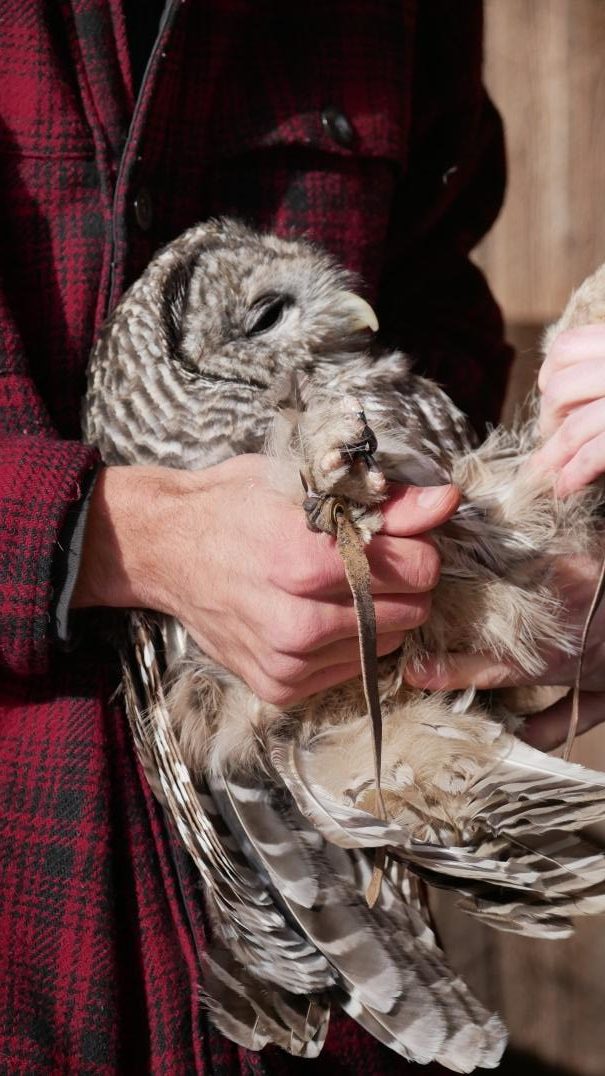
Oberon gets a health check and talon trim thanks to our friends Nathan and Grae from VINS.
On December 12, Nathan Thoele and Grae O’Toole from the Vermont Institute of Natural Science (VINS) made the trip up from Quechee, VT to check on the health of our beloved ambassador owl, Oberon. Nathan is a NorthWoods’ Conservation Corps and AmeriCorps alum, and was Oberon’s caretaker during his time with us before moving on to become an Environmental Educator at VINS. Nathan and Grae generously donated their expertise to make sure Oberon was in tip top shape and to provide training for our staff in the preservation of ‘bio-facts’ from more than 10 frozen specimens salvaged and brought to NorthWoods. NorthWoods maintains a Federal Wildlife Collection permit that allows us both to care for Oberon in captivity, and also to keep salvaged specimens for educational purposes.
The visit began with Oberon’s health check. His beak was in good shape but needed a touch up and his talons were long. In a secure, fetal like position Grae held Oberon against her stomach facing outward while Nathan took up the nail clippers and trimmed his talons. After, Nathan pulled out the Dremmel tool and began honing Oberon’s beak until suitable. Grae completed the health check, confirming the existence of the injuries that resulted in Oberon’s initial rehabilitation and subsequent homing at NorthWoods in 2006. She found a well-healed fracture in his left wing, and blindness in his left eye. She also confirmed his behavior as being consistent with raptors who have suffered from neurological damage. Grae revealed his ears which are buried deep beneath the feathers of his facial disk. While some say eyes are windows to the soul, a rare and up-close look in an owl’s ears give a full inspection of the back of his large eye balls, supported not by muscle (too heavy) but by hollow bony structures called sclerotic rings.
Nathan and Grae assured us that Oberon’s current feeding schedule and quantity was perfect – 50 grams of food per day, supplemented with Vitahawk nutrients. While we have an ample frozen supply of laboratory mice, they confirmed it was fine to include captured mice in his diet, although this would NOT have been true if it was possible the captured mice or other small rodents may have ingested poison – one of the major threats posed to wild birds of prey, and the reason we do not support the use of rodenticides. While they worked, Grae informed us that in order to get an indication of his weight, she felt for and slid her fingers along Oberon’s keel bone. The keel bone is like an extension of the sternum in the middle of the chest, and anchors a bird’s all-important wing muscles. If the keel bone is sharp and prominent, the bird is underweight, if prominent but not sharp, the bird is at weight, and if obscured by the breast on either side, the bird is overweight.

NorthWoods staff learning to create bio-facts from deceased wildlife specimens.
We are glad to report that Oberon was at weight and healthy! Nathan also made some suggestions to help us provide Oberon improved enrichment and help him manage the natural anxiety of being a wild animal in captivity. This includes increased general handling, and taking him on more frequent walks in the forest (secured to a handler’s glove).

Wings and talons set to dry and soon to be incorporated into our education programs!
Next we convened in the lodge to uncover the many bird specimens that had been thawing from their time in storage. Our permit allows us to keep specimens of federally protected wild birds which have sadly been found deceased. The challenge is in turning these into educational tools that will help our visitors learn about the wonders and adaptations of the native species in our region. This is where Nathan’s expertise came in, showing us how to preserve the wings and feet and turn them into ‘bio-facts’ for our visitors. He showed us how to break the feet at the joint with the leg to prevent exposing fractured, sharp bone. We practiced removing the feet and mounting them in foam and cardboard to a desired position. Nathan then demonstrated where to break the wing. We mounted the wings by spreading them out on cardboard and securing them with tape.
The bio-facts are currently drying and soon we’ll be able to share these specimens in our education programs. The opportunity to be hands-on, for kids and adults, will be fascinating and reveals so much more than a photograph. Soon, we’ll be able to compare the feet and talons of an American Bittern to a American Woodcock, and see, hear and feel first-hand the serrated leading edge of the flight feathers of a Barred Owl (for silent flight, but slower) versus the smooth edge of a Cooper’s Hawk (fast, aerodynamic flight but noisy).
We concluded the visit by brainstorming follow up visits for training purposes including a field trip to VINS. Oberon’s next out-of-mew visit will be at Burke Mountain Hotel on the evening of December 30.
A huge thank you from all of the staff (and Oberon!) to Nathan and Grae for donating their time! Please make sure to stop by VINS for a great wildlife experience next time you are in Quechee!

